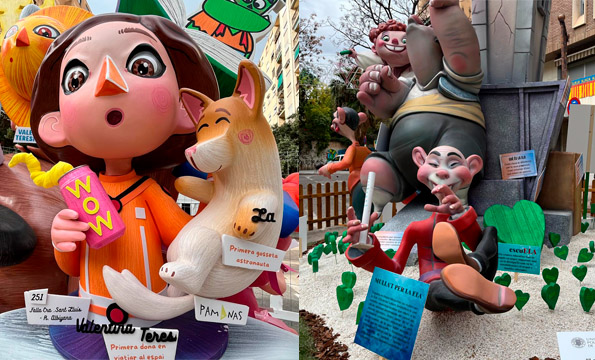Carrera San Luis-Rafael Albiñana and Nador-Milagrosa, winners
Curie, Goodall, Tereshkova, and ALS research take center stage in the second edition of La Ciència a les Falles
[ 21/03/2025 ]
The Fallas commissions Carrera San Luis-Rafael Albiñana and Nador-Milagrosa were the big winners of the second edition of the Premio “La Ciència a les Falles”, an initiative promoted by the Universitat Politècnica de València (UPV).
Carrera San Luis-Rafael Albiñana won first prize in the children's category with a falla highlighting pioneering women in science, including Marie Curie, Jane Goodall, and Valentina Tereshkova. Meanwhile, in the adult category, Nador-Milagrosa took home the top award with its falla “Mójate por la ELA”, which underscored the vital role of scientific research in the fight against this disease.
Female role models, the factory of life, Dexter, and vaccines
Carrera San Luis-Rafael Albiñana’s falla emphasized the importance of women in history and how they inspire today’s girls. Five young girls dressed as their role models took center stage: alongside Curie, Goodall, and Tereshkova, two more represented Clara Campoamor and Mary Shelley, aspiring to follow in their footsteps.
"Throughout history, women have been silent protagonists of major societal changes. Emerging from the shadows of a world that often sidelines their contributions, female figures have challenged norms, broken barriers, and paved the way for the freedoms we enjoy today. This message is beautifully captured by the five girls at the heart of our falla," explained the commission.
Second place in this category went to the Sainetero Arniches-Arquitecto Ribes commission for its falla “La fábrica de la vida”, a creative and educational tribute to the Blood Transfusion Center of the Valencian Region. The display featured a striking central heart filled with gears, playful ninots reminiscent of the legendary TV series “Once Upon a Time... Life”, and a visually engaging selection of glowing brains representing different fields, including science and invention. The falla also strongly advocated for more significant investment in scientific research.
Third place was awarded ex aequo to the Pascual Capuz-Fontanars and Guillem Sorolla-Recaredo commissions. Pascual Capuz-Fontanars won recognition for a fun ninot of Dexter, the famous animated scientist with a secret bedroom lab, known for his brilliant inventions and problem-solving skills. Guillem Sorolla-Recaredo’s falla stood out for a scene highlighting the crucial role of vaccine research in controlling and eradicating diseases.
A pioneering falla on ALS and artificial intelligence
In the adult category, Nador-Milagrosa claimed first prize with “Mójate por la ELA”, the first falla in the history of València’s Fallas festival dedicated to raising awareness about ALS. The display emphasized the importance of scientific research in combating the disease and featured tributes to well-known figures affected by ALS, such as physicist and science communicator Stephen Hawking and former football goalkeeper and coach Juan Carlos Unzué, now one of Spain’s leading advocates for ALS patients’ rights.
The second prize went to the Mistral-Murta Commission for a headless ninot warning of the dangers of neglecting human intelligence in favor of artificial intelligence. Third place was left vacant.
“A spectacular fusion of science and Fallas creativity”
"This year, we’ve witnessed an incredible fusion of science and Fallas creativity. The winning fallas prove that Fallas’s art is a powerful medium for raising awareness about research, highlighting the role of women in science, and addressing urgent causes like the fight against ALS. Once again, this UPV initiative has demonstrated that Fallas are more than just a festival—they are education, social awareness, and a wonderful bridge between the university and the community," said José Francisco Monserrat, Vice-Rector for Internationalization and Communication at the UPV.
Alongside him, the jury for the second edition of the Premios La Ciència a les Falles included Salomé Cuesta, Vice-Rector for Art, Science, Technology, and Society; Juan Sebastián Ortiz, president of the UPV falla; and Luis Zurano a journalist from UPV’s Communication Office.
The Premio “La Ciència a les Falles” is an initiative led by the Universitat Politècnica de València to bring science closer to society through the city’s biggest festival. It is part of UPV’s annual science communication and outreach program. The UPV Communication Area coordinates it through its Scientific Culture and Innovation Unit in collaboration with the Fallas Commission Avda. Tarongers – Universitat Politècnica-Camí de Vera. The initiative also receives support from the Spanish Foundation for Science and Technology (FECYT) of the Ministry of Science, Innovation, and Universities
Outstanding news
 The Diamond Army
The Diamond Army
Two students came up with the UPV initiative that has engaged more than 1,600 volunteers and shattered the false myth of the 'crystal generation'
 ARWU 2024
ARWU 2024
The Shanghai ranking reaffirms the UPV as the best polytechnic in Spain for yet another year
 Distinction of the Generalitat for Scientific Merit
Distinction of the Generalitat for Scientific Merit
Guanter has been distinguished in recognition of his research excellence in the development of satellite methods for environmental applications
 The new statutes come into force
The new statutes come into force
The Universitat Politècnica de València is the first university in Spain with statutes adapted to the new LOSU
 NanoNIR project against breast cancer
NanoNIR project against breast cancer
UPV Researcher Carla Arnau del Valle receives an EU Marie Curie grant to develop biosensors for the early detection of this cancer
 Large artificial intelligence language models, increasingly unreliable
Large artificial intelligence language models, increasingly unreliable
According to a study by the Universitat Politècnica de València, ValgrAI and the University of Cambridge, published in the journal Nature





